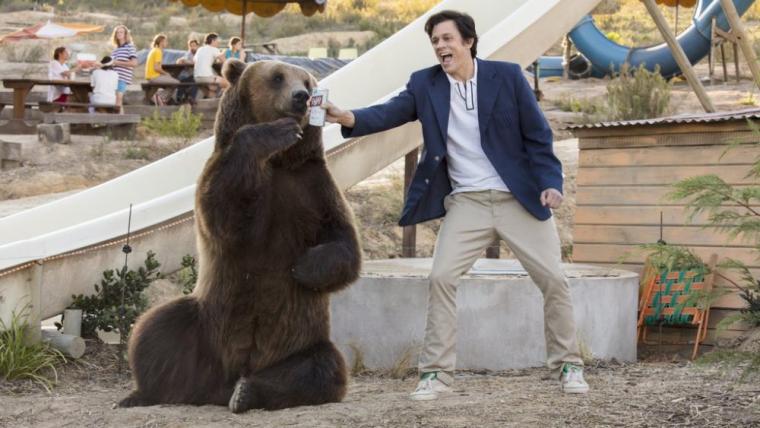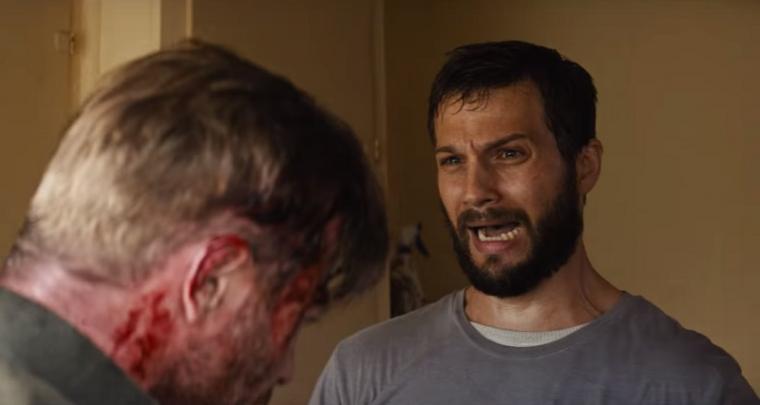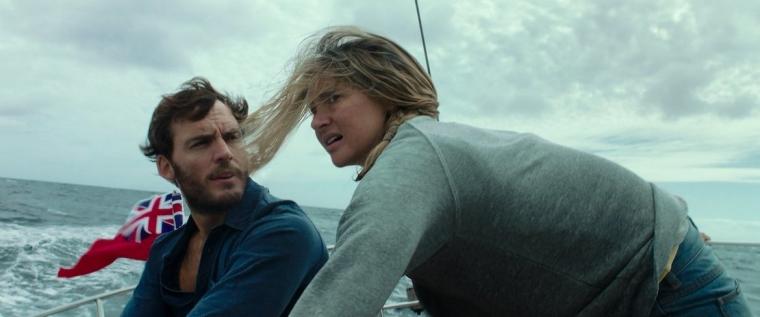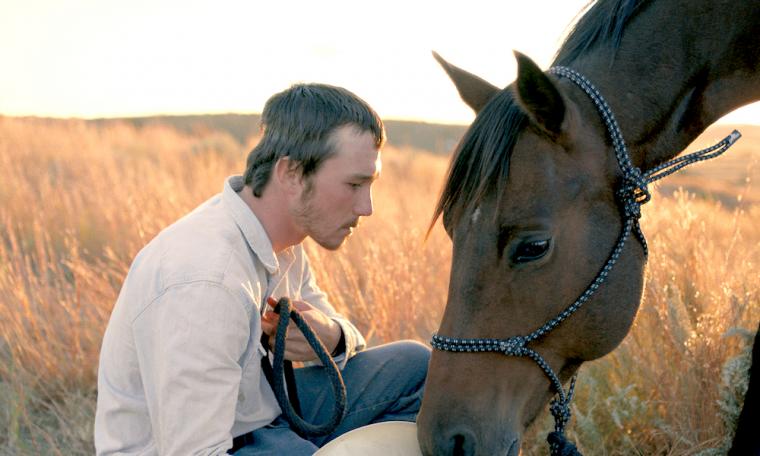
ACTION POINT
As the movie's star has recounted, among the many injuries Johnny Knoxville suffered while filming his new comedy Action Point were concussions, broken bones, and the loss of “two-and-a-half teeth.” Did they happen to be his fangs? I ask because director Tim Kirkby's stunt-filled slapstick, despite its expected R rating, is about as close to a family-friendly Jackass as Knoxville has attempted, and I don't mean that admiringly; even before its famously fearless, possibly deranged lead walked on set, this thing was destined to be toothless.
Its nominal plot finds Knoxville's D.C., in some unspecified late-'70s/early-'80s period, the proprietor of America's most unsafe – and, from the look of things, uninteresting – theme park, and deciding to up the danger quotient after corporate d-bags build another theme park a half-hour away and offer to buy Action Point for kindling. This is one of those movie narratives that really only work for Muppets, but this is an outing in the Jackass mold, so we're not here for story. Bring on Knoxville getting power-hosed down a water slide! Bring on the squirrel rummaging around in Chris Pontius' shorts! Bring on the enormous brown bear guzzling Schlitz! (Actually, bring that on a bit less, please; finding the Schlitz plug in every scene is like playing the world's easiest game of “Where's Waldo?”)
Sadly, though, blandness rears its head with the arrival of D.C.'s daughter Boogie (Eleanor Worthington-Cox), a ninth-grader who witnesses all of the horrific shenanigans around her and still thinks her dad's park, and her dad, are awesome. It might've been, and he might've been, had the film not been so insistent on making D.C. a lovable underdog who can't catch a break, especially when Knoxville's persona is the exact opposite of lovable. (His cackling giddiness whenever someone other than him gets hurt gives the guy away every time.) Yet we're also stuck with this tale being told in flashback, with Knoxville's elder D.C. – appearing under similar though less severe prosthetic makeup than in 2013's Bad Grandpa – recounting his Action Point saga to his granddaughter, who gazes at him with the same unfettered adoration that Boogie once did. (Even Susan Yeagley's now-grown Boogie addresses her pop with eye-rolling good humor and “Oh, you sweet so-and-so!” deference.) None of this would likely have mattered had the injurious stunts on display been Jackass-level gut-busters. Yet they're not; barring very rare surprises such as D.C. getting smacked in the nuts by a loose picnic-table board, the violent mania is too dull and, dare I say, safe-looking to elicit the joyous, cathartic effect of Knoxville's previous efforts. Concussions and lost teeth aside, Action Point is harmless in the most disappointing way, and proves that at least half the fun of the original Jackass movies and TV show was found in the raucous laughs of those surrounding Knoxville whenever he cheated death, or simply endured painful humiliation, and lived to tell of it. Now, after pratfalls, everyone around him just looks concerned. He's become a Bad Grandpa, and there's very little that's funny about that.

UPGRADE
Movie preludes are so routinely by-the-book – several commercials, six or seven trailers, an awkwardly timed reminder to buy soda and popcorn, the studio-logo appearance, listings of numerous production companies – that it's easy to enjoy the little things. In writer/director Leigh Whannell's Upgrade, for instance, I was jazzed by those production companies not being shown to us, but rather spoken to us (as was the film's title) by a roboticized voice reminiscent of Scarlett Johansson's in Her – a clever bit that nicely underlined the impending film's OS-run-amok theme. Little did I know, however, that this sci-fi action thriller would, rather miraculously, find ways to keep me jazzed through the entire course of its 95 minutes. Given that the trailers made the film look, at best, like a Blumhouse-ed take on Robocop, I'm a bit leery about admitting just how good I think this down-and-dirty entertainment really is. But I also left the movie so wowed by its wit, smarts, and imagination – and amazed that it was way funnier than most 2018 comedies to date – that I'm afraid I won't be able to do justice to its nasty but considerable appeal.
Whannell was the screenwriter for a couple of Saw movies and all of the Insidious movies (he also directed Insidious: The Last Key), but nothing about his filmography suggested that he was capable of pulling off a truly first-rate episode of Black Mirror, which is exactly what Upgrade suggests. Set, as most Black Mirrors are, in the not-too-distant future, Whannell's film casts Logan Marshall-Green as Grey Trace, an old-school mechanic whose wife (the charming Melanie Vallejo) is gunned down in front of him during an apparent robbery, and whose consequent spinal-cord injury leaves him a paraplegic. Enter Eron (Harrison Gilbertson), a zillionaire weirdo with a sweaty upper lip who tells Grey that he's invented a device – a computerized roach called Stem – that can get him walking again. Grey grudgingly agrees to have the thing attached to his spinal column, and after his procedure is over, the man can indeed walk. And move with lightning speed. And actually hear Stem (voiced with priceless HAL-the-computer cadences by Simon Maiden) engage in internal conversation. From there on, Upgrade is basically about Stem helping Grey find and kill the men who crippled him and murdered his wife. Except that's not what it's about. Or rather, that's not all that it's about.
Giving away further details would be to deprive you of the movie's considerable element of surprise; you may think you're at Robocop 2018, but you're actually at some bizarre, thrilling hybrid of Ex Machina, John Wick, and Hardcore Henry, but without the debilitating nausea. (Whannell's outing is the movie I hoped Hardcore Henry would be before my discomfort made me bolt the theatre halfway through.) Suffice it to say I had an absolute blast. With Stem able to take over Grey's movements with his host merely saying “Take over, Stem,” the film boasts hilarious, marvelously choreographed, incredibly bloody fight scenes that had me wincing and roaring in equal measure. Marshall-Green, who looks uncannily like Tom Hardy, is a riot even when he's merely walking, his android-like sharp turns and erect posture a source of constant amusement. (When Stem is operating at only 70-percent capability and Grey can no longer move his leg, he's like Steve Martin in a more high-stakes version of All of Me.) The supporting cast is topnotch, with Benedict Hardie truly sinister as a psychopath with a child-molester mustache, and Get Out's great Betty Gabriel sensational as a dogged detective. (Here's hoping that Gabriel – who was also outstanding in 2016's The Purge: Election Year – is only days away from an actual lead in a Blumhouse offering.) And with the film's subtle yet unmissable commentary on the disparities between the haves and the have-nots – this universe's rich being allowed to glide about in driver-less cars and enjoy other amenities that mechanics and their ilk are denied – Whannell demonstrates that there's far more to his talents than jump-scares in the Saw and Insidious vein. I had the time of my life at Upgrade. It may be a B movie to its teeth, yet it's one wholly deserving of an A, or at least an A-minus – a genre work totally worth the upgrade.

ADRIFT
Variants on the phrase “based on a true story” appear at the beginnings of movies all the time, so I'm hardly going to fault director Baltasar Kormákur for employing the device in Adrift. But this survival drama did make me question the point of such early acknowledgment. Shouldn't fiction and nonfiction works engross us equally regardless of their connections to real life? Don't we instinctively make a pact with filmmakers to buy into whatever they're selling – Johnny Knoxville running a theme park, computer chips healing a human body, Will Arnett partnering with a talking dog – for as long as we possibly can? Or is the “true story” tag actually a preemptive strike against possible complaints? Here, for instance, watching the hurricane-swept Shailene Woodley and Sam Claflin trapped in a downed yacht in the middle of the Pacific, does “based on a true story” forfeit our right to ask for a second storm, or a school of sharks, or an outbreak of scurvy, or something to alleviate the tedium?
In fairness, this adaptation of Tami Oldham Ashcraft's and Susea McGearhart's Red Sky at Mourning: A True Story of Love, Loss, & Survival at Sea at least finds Kormákur and his trio of screenwriters wise enough to chronologically fracture their narrative, with scenes of oceanic despair and ingenuity dovetailing with scenes of Woodley's Tami and Claflin's Richard meeting, falling in love, and setting sail in Tahiti. Although Adrift's attractive, perfectly pleasant stars banter and flirt convincingly enough, they don't share the sort of undeniable chemistry that would make their romance memorable, and the Tahitian sequences would've made for a sluggish Act I without the post-hurricane interruptions. Sadly, however, I was just as relieved to have the couple's mid-Pacific ordeal – Woodley able-bodied but with a sizable head wound, Claflin immobile with a broken leg and ribs – interrupted by flashbacks to happier times, even though they immediately undercut whatever survival-flick tension Kormákur was trying to establish. While Tami's problem-solving skills and nautical know-how are impressive and inspiring, they're not terribly cinematic, and so the film feels like it's suffering from two separate forms of heatstroke, with cheerful Tami and Richard lolling under the sun, and miserable Tami and Richard suffering under it. Cinematographer Robert Richardson provides exquisite overhead shots of the ocean's empty beauty, but the whole thing comes off as weirdly empty: It's All Is Lost without the eerie silence; Gravity without Cuarón; Life of Pi without the tiger. Unfortunately, it's also the year-to-date's most aptly titled movie.

THE RIDER
Arriving locally in this season of pricey sequels and reboots and sequels to reboots, audiences may rightly wonder just what The Rider is. A Nicolas Cage Marvel movie with the “Ghost” hacked off? A re-enacted list of demands from Tom Cruise's sixth Mission: Impossible contract? Actually, no: Writer/director Chloé Zhao's drama, a prize winner at last May's Cannes Film Festival, is a deliberately paced, taciturn, meditative character piece about a young South Dakota cowboy who, after suffering a debilitating rodeo injury, is forced to face an uncertain future. So, ya know, Jurassic World 2 it most definitely is not. But even if you steadfastly insist on a summertime cineplex diet of only empty calories, I urge you to give Zhao's movie a try, because this thing is phenomenal – gripping and haunting and emotionally overwhelming, and boasting performers and a milieu you haven't seen before and quite possibly won't see again. The Rider may seem like the “wrong” movie for the season, but that in itself makes its area appearance nothing but right.
Ironically, while Adrift is a true story acted by famous people, The Rider is a work of fiction, even though nearly everyone on-screen is playing a character modeled on him- or herself. Brady Jandreau, a charismatic, commanding figure with more than a hint of Adam Driver melancholy, is our protagonist Brady Blackburn, a Native American trying to negotiate a new, unwanted existence in which he's forbidden to ride a horse – and consequently forbidden the only life he's ever known or wanted. Jandreau's real-life father Tim plays his father Wayne, an inveterate drinker and gambler yet one not without a stoic kindness. Real-life younger sister Lilly plays younger sister Lilly, a fundamentally happy and wise (and frequently singing) sibling born with an intellectual disability. Real-life best friend and mentor Lane Scott plays best friend and mentor Lane Scott, whose own rodeo accident left him paralyzed, unable to speak, and restricted to life in a hospital.
And so it goes with all of Brady's pals and neighbors and acquaintances in The Rider's Lakota Sioux reservation – non-professionals all, and not a weak presence in the bunch. There isn't much plot in Zhao's follow-up to her Songs My Brothers Taught Me debut – not that, given her beautiful compositions and the regional gorgeousness of Joshua James Richards' cinematography, you could conceivably want more. But the film is so incisive in its depiction of character and locale that you're frequently knocked out merely by its participants being “themselves”: Brady and his cowpoke buddies around a campfire, drunkenly reliving their most horrific accidents and, removing their hats, offering a prayer for Lane; Brady, dejectedly stocking shelves at his reservation's grocery store, politely enduring the hero worship of two customers who can't fathom why he's working there; Brady, driving home after a heartbreaking visit with Lane, pulling to the side of the road so he can quietly cry.
Best of all are the scenes of Brady in his natural element training wild horses and, with the utmost care, slowly getting them to allow him to sit on their backs. In 1998's The Horse Whisperer, Robert Redford made this seem an almost mythological act, with steeds quickly calmed by the presence of one laconic, blond, middle-aged movie star. Zhao and Brady Jandreau – the latter pulling off feats that no Hollywood actor ever could – bypass the superhuman and give us something far more magical: the sight of an intensely gifted professional doing his job with enormous skill, patience, and love. Jandreau, who's in almost every frame of the movie, is eminently watchable whether he's navigating Lane through a difficult physical-therapy session or twirling a pricing gun like a six-shooter. But this tremendous natural actor is a true star when sharing the gifts that have obviously come from a (20-something) life's work as a cowboy, and you're in thrall to him to the way you are to composer Nathan Halpern for his rich, never-manipulative score, and to Zhao, who's like Terrence Malick without the portentousness. When asked what the film is “about,” you could easily reply that it's about the sound of a hand brushing against a horse's neck, or a warm breeze through a field of thistles, or rain on the tin roof of a trailer. But it's also about the American West – specifically, the people of the American West, whom the miraculous The Rider views in all of their failings, contradictions, and exhilarating humanity. When Brady puts on his white cowboy hat, partially as a way to hide the visible staples in his skull, never has the accessory looked quite so heroic.










